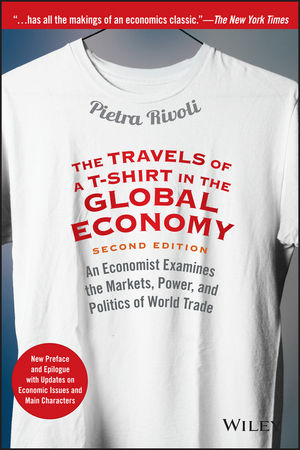The Travels of a T-Shirt in the Global Economy Summary
4 min read ⌚
 An Economist Examines the Markets, Power, and Politics of World Trade
An Economist Examines the Markets, Power, and Politics of World Trade
Have you ever wondered where the t-shirt you’re currently wearing came from? It’s time to find out! And there’s no better way to do that than reading Pietra Rivoli’s “The Travels of a T-Shirt in the Global Economy.”
About Pietra Rivoli
Pietra Rivoli is a professor of Finance and International Business at Georgetown University’s McDonaugh School of Business ever since 1983. Her only book, “The Travels of a T-Shirt in the Global Economy” was both a bestseller and the finalist of few 2005 business awards. In 2008, it was even adapted into a play.
is a professor of Finance and International Business at Georgetown University’s McDonaugh School of Business ever since 1983. Her only book, “The Travels of a T-Shirt in the Global Economy” was both a bestseller and the finalist of few 2005 business awards. In 2008, it was even adapted into a play.
“The Travels of a T-Shirt in the Global Economy Summary”
In 1999, Pietra Rivoli, a Georgetown University professor and economist, attended an anti-globalization rally. “Who made your T-shirt?” – a young woman asked the crowd, before listing numerous labor abuses happening worldwide as you read this.
Pietra Rivoli did something even better – she started a step-by-step journey to discover the origin of the t-shirt she was wearing at the moment.
What she ended up with was a book about globalization. And, contrary to her initial belief, a book-length study about how avoiding market forces created the textile industry. In addition to contributing to the suffering of millions of innocent people.
Visualized, Rivoli’s journey looks something like this. And we’re following both her footsteps and conclusions from start to finish. With few necessary historical digressions.
Rivoli bought her T-shirt at a Walgreen’s drugstore in Florida. She checked the label and phoned the Sherry Manufacturing Company. Its president, Gary Sandler, introduced Rivoli to Patrick Xu, his main supplier.
You can guess by the name that he was from China. However, when Rivoli met him in Washington and asked him where they got the cotton from, he replied “Texas.”
And as Rivoli soon discovered, most of the T-shirts today start there. More precisely, in Lubbock, the largest cotton-growing region of the world.
But how did that happen?
Well, you can guess most of the historical digression. Unsurprisingly, it has a lot to do with human exploitation.
And it starts in the 18th century, when the British introduced mechanization in the textile industry. Soon, textile became its chief industry – and a national secret. However, a certain Francis Cabot Lowell memorized the design of the power loom and brought it into the United States.
And then Eli Whitney invented the “cotton gin” which made “upland cotton” profitable, the US a textile powerhouse, and, of course, slavery an economically sound premise.
Planters started adopting several practices to make sure none of their slaves would develop a case of drapetomania. They blocked their public education and made sure they are poor enough to have no other option but working for them 24/7.
Talking about centuries of injustice!
And if you think that something changed in the 20th century – then, you’re right. But, you’re almost definitely wrong on what that “something” is.
A hint: it’s the people.
Namely, Second World War gave Texas cotton laborers an opportunity to flee the farms, by enlisting for the U.S. military forces.
However, the planters made an agreement with the U.S. government to import Mexican workers. And the Bracero program lasted well into the 1960s.
Of course, the cotton from Texas is turned into T-shirts somewhere in China by people living in basically the same gruesome conditions. Slavery, the Bracero program, and Chinese regulatory policies have really helped the textile industry. But, they haven’t helped the people.
In Rivoli’s opinion, free market would have done exactly that.
Because, once Rivoli discarded her T-shirt, she found out that it was exported as a second-hand clothing item to Tanzania. There Rivoli finally found an open market. Which worked better than the ones in the developed economies of the world.
And that’s Rivoli’s solution: bring the free market to the U.S. And make it a world practice.
For everybody’s benefit.
Key Lessons from “The Travels of a T-Shirt in the Global Economy”
1. A T-Shirt Journey Is a Story About Economy and Globalization
2. The Textile Industry Profited from Unethical Behavior
3. Freeing the Market Means Freeing the People
A T-Shirt Journey Is a Story About Economy and Globalization
In 1999, Pietra Rivoli attended an anti-globalization gathering. She heard one of the young women present in the crowd shout: “Who made your T-shirt?” That inspired her to try and scrutinize all aspects of the question. And “The Travels of a T-Shirt in the Global Economy” is her book-length answer.
The Textile Industry Profited from Unethical Behavior
The most alarming thing she discovered is that, in the case of the textile industry, free market has never been part of the equation. In Texas, from where most of the world’s cotton originates, slavery and the import of Mexican workers through the Bracero program was used to avoid the free market. In China, it’s population controls which do the trick. The sad thing is – that they all actually work.
Freeing the Market Means Freeing the People
However, if something unethical works, it doesn’t mean that we should just sit back and reap the benefits. After all, rape and genocide are, strictly evolutionary speaking, very attractive ideas. The same is true for slavery. However, this doesn’t mean these are ethically justified policies. Of course, they are not.
And Milton Friedman argued convincingly back in 1960 that human freedom comes from economic freedom. So, free the market – free the people!
Like this summary? We’d Like to invite you to download our free 12 min app, for more amazing summaries and audiobooks.
“The Travels of a T-Shirt in the Global Economy” Quotes
This book is the story of the people, politics and markets that created my cotton T-shirt. It is a story about globalization. Share on X For over 200 years, the United States has been the undisputed leader in the global cotton industry… and other countries, particularly poor ones, have little chance of catching up. Share on X Remarkably, U.S. government subsidies under the cotton programs – approximately $4 billion in 2000 – exceed the entire GNP of a number of the world’s poorest cotton-producing countries. Share on X The Chinese government controls (a factory worker’s) life in ways that are bad for China’s human rights record, but very good for the production of T-shirts. Share on X Since completing my travels, I have come to believe in a moral case for trade that is even more compelling to me than the economic case. Share on X
Emir is the Head of Marketing at 12min. In his spare time, he loves to meditate and play soccer.


 An Economist Examines the Markets, Power, and Politics of World Trade
An Economist Examines the Markets, Power, and Politics of World Trade



